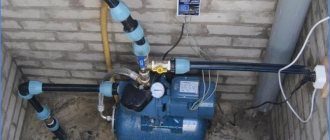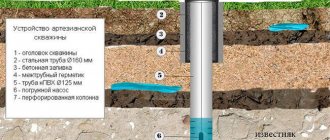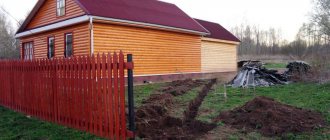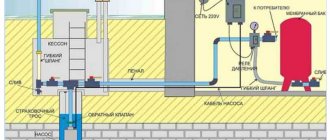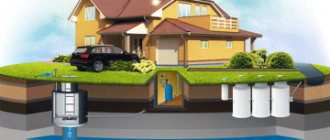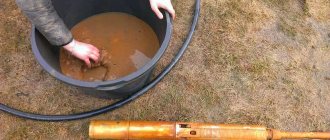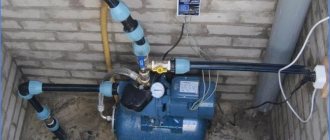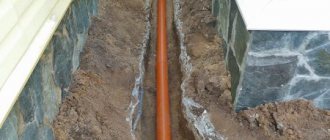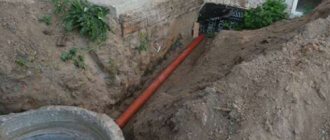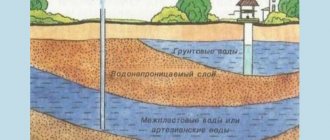The first thing the owner of a country plot, be it a rural farmstead or just a vegetable garden, should do is ensure water supply. It would be good if a centralized water supply system was built, but, alas, it is not available in every area. In such a situation, there is only one thing left to do - extract water from underground. Contrary to popular belief, this event is not always extremely expensive, because the technology of drilling a well under water can easily be mastered by a self-taught person who is accustomed to doing everything on his own.
About methods for constructing wells
A well for water extraction can be constructed in different ways. How to make a well in a country house with your own hands and its specific type depends on how deep the aquifer lies .
Hydrogeologists distinguish three ranges:
- up to 12 m;
- from 12 to 50 m;
- from 50 to 200m.
Up to 12 m
, an Abyssinian well (needle well) is constructed on surface aquifers . It is important to note that often above this horizon there may be a “perch” - an aquifer with a large amount of pollution coming from the surface of the earth. Water from it cannot be consumed.
The well must penetrate the perched water and reach an aquifer with acceptable water quality. Making an Abyssinian well is quite simple:
- We start with the construction of a shallow well. Many people know how to drill a well with their own hands. You need two things: enthusiasm and a garden auger. The diameter of the well can be small, 40 mm will do. Instead of a garden auger, you can use an ice auger by removing it from the collar and attaching it to an extendable rod. Drilling is carried out until the extracted soil has a liquid-like consistency. This means that you have reached the quicksand.
- Next, a pipe with a diameter of 1 - 1.5 inches with a conical tip (or pointed end) and a filter at the very bottom is lowered into the well. The filter is made like this: many holes are drilled in a section of pipe 80–100 cm long, then a purchased mesh is welded onto this section or wire is wound with a gap of 1 mm between the turns.
The photo shows a diagram of the construction of an Abyssinian well (needle well) - Having filled the pipe with water, they begin to hammer it into the quicksand, piercing it like a needle.
- As soon as the water from the pipe goes down sharply, the dive is stopped. Now the well needs to be flushed with clean water, after which it can be used.
Note: If a steel pipe is used for an Abyssinian well, its end can be “sharpened” by flattening it with several blows of a sledgehammer.
Often the water in the pipe after a puncture is high enough that it can be pumped out using a surface pump. If it turns out to be deeper than 8 meters, you will have to do one of two things:
- dig an ordinary well and extract water using a bucket and a gate;
- build a larger diameter well with a casing pipe in which a submersible pump can be installed.
The productivity of an Abyssinian well is usually 1 - 1.5 cubic meters. m/h.
From 50 to 200 m
These depths are characterized by an aquifer formed by limestone. A well in limestone is called artesian . It has several advantages:
- contains crystal clear water;
- has a high productivity of 10 cubic meters per hour;
- can be used for more than 50 years.
This option could be considered ideal if not for two circumstances:
- an artesian well can only be built by qualified specialists with special equipment;
- the construction of such a facility is quite expensive.
Despite the fact that installing a well in a dacha with your own hands is impossible in this case, this option should not be discounted. The output of an artesian well will easily cover the needs of several areas, so very often residents of an entire street donate to its construction. As a result, everyone receives high-quality water at an affordable price.
In our separate article you will find more information about an artesian well on a summer cottage. Types of designs, necessary documents for registration and approximate cost of work.
You can learn about making well filters yourself by reading this article.
From 12 to 50 m
The middle depths are the kingdom of aquiferous sand. The water here is quite clean, but you won’t be able to get to it with just a shovel or a pointed pipe. Nevertheless, the desire to build a sand well on your own is quite feasible. You will need special equipment and deeper knowledge of the technology of drilling water wells with your own hands. It is sand wells that will be discussed further.
Each of the water intake sources is located on certain aquifers
Selecting a scheme for supplying water to a private house from a well
The water flow pattern is not complicated. The only thing worth paying close attention to is the pump that pumps water from great depths. A submersible pump can be located in a well; surface installation does not require immersion.
In the case of a submersible pump, water will be supplied from a great depth. However, a surface pump is easy to install, easy to repair, and it is worth choosing if you live in a house during the warm season. Its only drawback is that it is not capable of pumping water if the depth exceeds 8 m.
It is also important to take into account the removal along horizontal areas on the surface. For example, to transport water through a horizontal pipe 10 meters long, it is necessary to spend the same amount of effort as to lift water 1 m. This means that the source of drinking water should be located as close as possible to the cottage.
Before installing the accumulator, the corner outlet must be installed. From there the water will flow into the accumulator tank. It is made in the form of a tank made of steel or plastic. Inside it there is a rubber tank with air.
Due to the compressible volume, pressure is generated in the system, so the water rises to consumers. This process is explained by the fact that water does not have the property of compression, while air, on the contrary, can be compressed.
The automatic system monitors that the pressure level is normal. If it is insufficient, the pump will turn on; when the pressure rises to the set value, it will turn off. As a result of coordinated work, the system will have optimal pressure, and water will be supplied to consumers without interruption.
When choosing a hydraulic accumulator and pump, remember that they must have sufficient power, it is better to have it with a reserve. To do this, it is important to consider the maximum possible water flow. To carry out calculations, it is necessary to take into account all points of consumption: kitchen, restroom, washbasin, shower, bath, water supply for watering the garden.
In addition to the pump and storage tank, it is necessary to install a check valve to prevent water from flowing back into the well, as well as a safety valve to relieve pressure. All kinds of sensors, relays, shut-off valves, and filter elements will also be required.
It is important to install oblique sand filters to prevent sand from getting into the system. Fine filters should be selected taking into account the results of chemical analysis of water.
It is important that autonomous water supply lines are limited by shut-off valves. It is best if they are collapsible, using “American” ones.
The final system package may vary depending on your requirements. However, you cannot do without a pump, as well as a hydraulic accumulator.
When the well layout is based on a hydraulic accumulator, a submersible pump will supply water to it. The hydraulic accumulator can be located in the basement, boiler room or in a caisson. The battery is made in the form of a container, which is separated by a membrane. One half contains water, the other air, so that the pressure in the system is optimal.
About drilling methods
Before you drill a water well with your own hands, you need to choose the type of drilling rig (there are three of them).
Shock-rope
A heavy load, called a chuck, as well as a special tool - a bailer - are suspended from the frame using a cable. From below, several strong triangular teeth are welded onto the cartridge, which weighs about 80 kg. By lifting it and dropping it, they loosen the soil, which is then removed with a bailer.
Before starting work, you need to make a shallow well using a garden drill. The chuck can be lifted manually, but it is better to use a rotary motor for this.
With the help of such simple equipment you can build a well yourself
This method is used when working on light or clayey soil.
Auger
The working body of such an installation is similar to a garden auger, only very powerful. It is made from a 100 mm pipe onto which a couple of turns of a screw with a diameter of 200 mm are welded. To make one turn, a round sheet blank is used with a hole cut in its center with a diameter of just over 100 mm. A cut is made along the radius of the workpiece, then the edges at the site of this cut are moved in two opposite directions, perpendicular to the plane of the workpiece.
Drilling a well with an auger
As the drill sinks, the rod on which it is attached is increased. The tool is rotated manually using a long handle made from a pipe. Every 50 - 70 cm the drill will have to be removed, and since as it goes deeper it will have more and more weight, for this it will be necessary to install a tripod with a winch.
Rotary
For all its complexity, this option is the most effective and versatile . Soil development is carried out using a drill bit attached to a constantly expanding pipe - a drill rod or column. Drill bits can have different designs, the choice of which depends on the type of soil being overcome at the moment.
Rotary drilling combines rotational and impact effects on the rock. In addition, the design of the drill column allows water or clay solution to be pumped into the well, which erode the soil and significantly speed up the advancement of the tool.
Next we will talk specifically about the rotary drilling method.
What questions need to be clarified before signing a contract?
Before you finally choose a drilling company and sign an agreement, it is advisable to find out a few points that relate to the well and other nuances. Ask these questions to company employees (for example, ours)!
- What is your company's drilling experience? Have you performed wells in our region?
- What is the probability of finding water in our area? At what depth are you planning to find it?
- What borehole diameter do you recommend and why?
- What casing pipes are suitable, from what material and thickness?
- How is pumping done? How long does it usually take?
- What to do with the soil that will be raised after drilling?
- What is included in yours: drilling, casing, pump installation, water supply to the house? Will this be done by one team or different ones?
- What equipment and tools will you use for drilling?
- What drilling method is preferable in our area?
- Is there a guarantee and for how long? What exactly is included in the warranty?
In addition, request an estimate of labor and materials. Check to see if there will be additional costs. If you plan to pay in installments, be sure to ask what advance payment is needed immediately and what the monthly payment amount is, whether there will be a commission, and what payment options are available. Find out, clarify everything and when you are sure, sign the contract and make payment!
Where to drill
Before starting any work, the hydrogeological situation should be clarified. The best source of information is the owners of surrounding properties , especially if they already have wells or have once tried to build them.
The second way to properly make a water well, or rather, choose a place for it, is to search for hydrogeological maps of your area, which can be stored in design organizations or relevant departments.
If it was not possible to obtain a clear idea of the presence and nature of aquifers, you will have to take the most expensive step - order exploratory drilling . However, before this you can try one of the folk methods , for example, dowsing, which, according to some evidence, can indicate with acceptable accuracy the presence or absence of water underground.
When choosing a location for a well, you should beware of neighborhoods in the form of septic tanks, cesspools, landfills or livestock farms. If they are still nearby, then they should be at a distance of no closer than 30 m. Of course, the well should be located closer to the house. The optimal distance is 3 m.
Water analysis
Having completed drilling, it is necessary to submit the resulting water for analysis to the nearest hydrogeological laboratory, SES.
If, based on its results, it is found unsuitable for drinking, the well is deepened to the next horizon. In cases where there are exceptionally deep horizons on your territory that are placed on the state balance (for private individuals their use is prohibited), such a source will have to be abandoned. This means that you will have to transport water from another place. For such drilling, a special license from the Ministry of Ecology is required, which is issued exclusively to legal entities.
It is optimal to order a comprehensive analysis of 15 main parameters, which includes:
- pH determination;
- color assessment;
- its rigidity;
- turbidity;
- performing a general analysis for Fe;
- permanganate oxidation values;
- detection of the presence of ammonium;
- sulfate ions;
- sulfide;
- presence of manganese;
- nitrate ions;
- nitrites;
- hydrogen sulfide;
- indicator of total salt content.
The resulting protocol has two columns: your data (left), MPC (right). It is necessary that yours do not exceed the limits, but rather be twice as low as them.
There is a detailed guide on sampling rules. Water must be collected in a clean bottle, previously washed with water from a well. The results obtained will allow you to choose the right filters to obtain truly clean water. It is advisable to conduct another analysis for the presence of bacterial contamination. Tests should only be performed in independent laboratories.
Equipment
To drill a well on a site with your own hands, you need to prepare the following elements:
- Tripod: assembled from three steel pipes or logs with a diameter of 16 cm. At the top point, the structure is connected by a pin.
- The following types of drill bits: a spoon drill (for sand and clay), a chisel (can be straight and cross-shaped) for hard rocks, as well as gravel and pebble layers, and a serpentine drill bit for clay. The quicksand pass with the help of the already mentioned bailer.
Different types of drill heads - Motor pump: used to supply the washing solution to the soil development area.
- Drill rod: assembled from 3-meter sections connected by means of a coupling or thread. A specially made rod can be replaced with water or gas pipes.
- Swivel.
- Winch.
- Geared motor.
- Pump.
- Steel or polymer pipe for casing. Its diameter is selected so that there is a gap of at least 5 mm (preferably 10 mm) between the walls and the pump installed inside.
- A filter column, which is a pipe with a filter and sump attached to it. You can make the filter yourself using the same scheme as for the Abyssinian well.
- Caisson.
Scheme of a household installation for drilling a well
Read about the characteristics and advantages of HDPE casing pipe with threads for wells in our separate article.
A comparison of wells and boreholes is available on this page of the site. All the pros and cons of these water intake sources.
How to connect a hydraulic accumulator to create a complete water supply system is described here https://okanalizacii.ru/vodosnabzhenie/nasosy-i-stancii/shema-podklyucheniya-gidroakkumulyatora-dlya-sistem-vodosnabzheniya.html
Pump selection and connection
The selection of a pump must be done after the well has been drilled. Because its selection should be based on the characteristics of the source. What you need to know to choose the right device:
- well depth and water column height;
- source performance;
- water consumption by consumers;
- diameter of the casing pipe.
Typically, either centrifugal or rotary submersible pumps are used. Another option is to use vibration devices. However, despite their cheapness, it is better not to use them, because... they destroy the walls of the well.
Submersible pump
When purchasing a device, you need to pay attention to its power and maximum lifting depth. These characteristics must be kept in reserve - if the pump operates at the limit of its capabilities, it will quickly fail.
Pump connection
To suspend the pump in a well, you need to use a strong steel cable - if the unit falls into the casing, it will be very difficult to get it out. In addition, it is advisable to be equipped with a simple winch - this will make it much easier to lower the pump into the casing. Moreover, the mass of the pipe is added to its weight.
Installation sequence:
- a check valve is connected to the pump;
- a coupling is screwed onto the valve and it is connected to the water pipe;
- the electrical cable must be secured with plastic clamps to the pipe every 2-3 meters;
- the pump is inserted into the well and installed at a depth of about 2 meters from the bottom;
- The cable and pipe are threaded through the head and secured with clamps.
After this, the water supply is connected to the main line and a test run is done. If the water comes out, then everything was done correctly.
Complete diagram of connecting a well to a country house
Let's start drilling
Here are general instructions on how to build a well in your country house with your own hands:
- A square excavation is made in the ground with plan dimensions of 1.5 x 1.5 m and a depth of 1 to 2 m - the so-called pit. It is necessary to prevent loose surface soil from falling into the well. The inside of the pit is lined with plywood or boards, and a boardwalk is laid on top of it for ease of installation work.
- After installing the installation, two coaxial holes are cut out in the upper and lower decks of the pit, after which they begin drilling.
- The drill rod is rotated using a gear motor or manually. At the same time, a support is placed on the bar, and one of the workers strikes it with a hammer. Alternatively, the drill is winched and dropped in a similar manner to cable percussion drilling. If necessary, water or drilling fluid is supplied to the rod.
- In parallel with drilling, a casing pipe with a special shoe installed below is installed into the well. Like the drill rod, it is gradually built up.
- After quicksand (soil with high moisture), drilling accelerates (the aquifer has begun), and then slows down again. This means that the waterproof layer has been reached and drilling can be stopped.
- A filter column is lowered into the well, after which it begins to be washed with strong water pressure.
- A submersible pump is lowered into the well and begins to pump out water until it becomes absolutely clean.
At the final stage of equipping a well at the dacha, a caisson is installed with your own hands, all cavities are filled with a sand-crushed stone mixture, and a pipeline is laid in a trench to the house.
Laying pipes when carrying water to a private house from a well
If your cottage permanently houses no more than 15 residents, water pipes with a diameter of 2 cm are suitable. They must be laid at a depth of at least 150 cm, that is, below the freezing point of the soil. To prevent water from freezing even at -35 degrees Celsius, it is important to use insulation, such as mineral wool. When the pipeline is on the surface, it will have to be insulated.
To install water supply in the local area, the pipes should be buried and an electric cable should be laid for heating.
When installing pipes, they are joined using a hair dryer or soldering iron. Such welded joints are strong and reliable. To cut pipes you will need a hacksaw. The best option is to use a lever cutter; it is usually included with the soldering iron. The pipes are placed in trenches and then brought into the residential building through openings.
Pipeline equipment is the final stage of external work. First of all, you need to drill a hole in the walls of the house, the diameter of which is 5 cm. Then it needs to be sealed with a sleeve, into which you then insert a pipe. After this, the hole is closed with construction foam, and finishing work is carried out on the surface.
;
Water
Did you find this article helpful? Share it with your friends:
Common Mistakes
The lack of experience of self-taught drillers most often manifests itself in the following:
- The drill is lowered too deep, causing the casing to cross the aquifer. Solution: lift the casing pipe or insert a new, shorter one into it, after which the previously installed pipe should be removed.
- The casing pipe did not reach the required depth, as a result of which the soil below collapsed and the productivity of the well dropped sharply. Solution: remove the soil with a bailer, then immerse the pipe to the required depth.
- The pump was installed too low, as a result of which the well became clogged with sand.
In the latter case, you should remove the pump and, having selected the sand with a bailer, install it correctly. The correct position is determined as follows: the operating pump is gradually lowered until sand is found in the pumped water. After this, the pump is raised slightly until the water it supplies becomes clean. (usually the correct position of the pump is 1-2 m from the bottom).
How to drill a well under water with your own hands and with the help of what equipment you can watch in the video.
What are the types of aquifers?
Obviously, you need to drill where there is an aquifer (horizon). It is important to understand that these layers are distributed at different depths, not evenly, based on the properties of the rock.
Based on their depth, there are the following types of groundwater:
- Soil - located almost near the surface. Precipitation adheres to solid parts of the soil and forms underground soil layers. They do not have a waterproof layer
- Perchal water is basically sediment that accumulates on top of the aquitard.
- Groundwater is found almost everywhere; it is formed by precipitation, water from lakes, rivers, and other bodies of water. This permanent aquifer lies on an aquitard.
Important! These three layers do not have their own pressure. If you make a well up to them, the water will not flow. That is why they drill to other interlayer horizons. In rare cases, drilling to groundwater is enough, but this is rather an exception.
- Interstratal is an aquifer that is sandwiched between two aquifers. There is pressure here and you can install a well - they are often called artesian. The water from it will rise and flow even without the help of a pump.
Filter
After casing is completed, it is necessary to install a filter (inside the casing). It is selected taking into account the identified properties of the developed horizon (composition and size of solid particles). The information is in the horizon description and obtained during the drilling process.
There are three types of well filters:
- perforated - a pipe with holes of a given diameter;
- mesh - a pipe with a wound fine-mesh mesh;
- slotted - with slotted holes.
The latter are the most in demand. Available with slot sizes of 300 microns (0.3 mm). Only thin sand is allowed through.
It is necessary to install the filter at the level of the developed aquifer (as accurately as possible). If you lower it lower, the water will flush the chamber up to the filter. The rock will begin to collapse here. The water becomes cloudy and difficult to clean. Its inflow from the reservoir is deteriorating. You can install the filter higher. However, there remains the possibility of it becoming clogged with materials from the overlying aquiclude. Up to its complete blockage. This means that the well will stop working. To select the exact position of the installation, it is necessary to first make a detailed section of the well, accurately determine the depth of the aquifer and its thickness (during the drilling process).
Aboveground pavilion-type structure
This is the simplest option for upgrading a well. For these purposes, a compact structure is used, which is placed above a hydraulic structure. Some recessing of such a pavilion is allowed. In this case, it will resemble an autonomous cellar, sprinkled with earth on all sides.
To do this, a small trench is dug before installing the structure. Industrial wells are most often equipped in this way. In the private sector, pavilions are rarely used, because its presence conceals the usable area and disrupts the aesthetics of the site. To insulate such a structure, a lot of effort has to be made.
